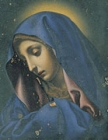Japanese Gallery (Honkan) Room T2
August 21, 2007 (Tue) - September 30, 2007 (Sun)
Christianity has played an integral role in the development of Japan since the 16th century. Introduced by Portuguese missionaries in August 1549, Christianity prospered under Oda Nobunaga (1534-1582), the warlord who first unified Japan. The authorities' position regarding Christianity gradually changed; four young Japanese men left Nagasaki to see Pope Gregory XIII in Rome shortly before Toyotomi Hideyoshi (1536-1598), Oda's successor, enacted an order that ordered the Christian missionaries to leave Japan. However, the order was not strictly enforced, and Hideyoshi died before he was able to continue efforts to remove the Christians. Tokugawa Ieyasu (1542-1616), Nobunaga's successor and founder of the Tokugawa Shogunate, eventually continued the purge. The Tokugawa Shogunate began to view Christianity as a more serious threat during the rebellion of Shimabara (1637-38). Following this, a hunt of hidden Christians, who continued to practice their faith, resulted in many martyrs.
In 1708 the Italian missionary Giovanni Sidotti Batlista arrived on the island and was arrested. He was taken to Edo and interrogated by Arai Hakuseki, an author and Confucian scholar. Afterwards, the ban on Christianity was strengthened, with notices posted and bounties paid to informants, in 1711.
After the fall of the Tokugawa Shogunate in 1867, the Meiji government initially continued the policy towards Christianity. However, rapidly modernizing Japan received criticism regarding this policy and lifted the order in 1873. This finally allowed the Japanese to have a greater degree of religious freedom.
This exhibition revolves around Christianity and missionary activity in Japan from before the Edo period until the Meiji period. Among the various artifacts, you will be able to see an Italian book that tells the story of the four young Japanese delegates who traveled to Rome, statues of Maria Kannon (a hybrid of Mother Mary and the bodhisattva Kannon to allow Christians to worship secretly), rosaries, crosses, and other items that were seized by the government. Other objects include twisted paper rosaries that were used while Christian faith continued to be repressed during the early Meiji period (1868-1912).

